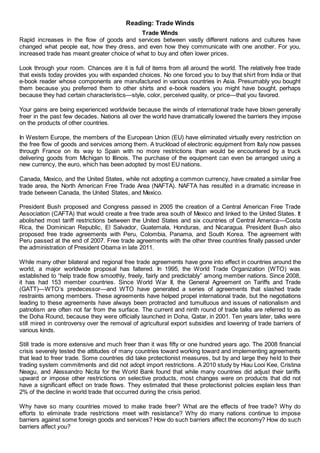
Reading: Trade Winds
- 1. Reading: Trade Winds Trade Winds Rapid increases in the flow of goods and services between vastly different nations and cultures have changed what people eat, how they dress, and even how they communicate with one another. For you, increased trade has meant greater choice of what to buy and often lower prices. Look through your room. Chances are it is full of items from all around the world. The relatively free trade that exists today provides you with expanded choices. No one forced you to buy that shirt from India or that e-book reader whose components are manufactured in various countries in Asia. Presumably you bought them because you preferred them to other shirts and e-book readers you might have bought, perhaps because they had certain characteristics—style, color, perceived quality, or price—that you favored. Your gains are being experienced worldwide because the winds of international trade have blown generally freer in the past few decades. Nations all over the world have dramatically lowered the barriers they impose on the products of other countries. In Western Europe, the members of the European Union (EU) have eliminated virtually every restriction on the free flow of goods and services among them. A truckload of electronic equipment from Italy now passes through France on its way to Spain with no more restrictions than would be encountered by a truck delivering goods from Michigan to Illinois. The purchase of the equipment can even be arranged using a new currency, the euro, which has been adopted by most EU nations. Canada, Mexico, and the United States, while not adopting a common currency, have created a similar free trade area, the North American Free Trade Area (NAFTA). NAFTA has resulted in a dramatic increase in trade between Canada, the United States, and Mexico. President Bush proposed and Congress passed in 2005 the creation of a Central American Free Trade Association (CAFTA) that would create a free trade area south of Mexico and linked to the United States. It abolished most tariff restrictions between the United States and six countries of Central America—Costa Rica, the Dominican Republic, El Salvador, Guatemala, Honduras, and Nicaragua. President Bush also proposed free trade agreements with Peru, Colombia, Panama, and South Korea. The agreement with Peru passed at the end of 2007. Free trade agreements with the other three countries finally passed under the administration of President Obama in late 2011. While many other bilateral and regional free trade agreements have gone into effect in countries around the world, a major worldwide proposal has faltered. In 1995, the World Trade Organization (WTO) was established to “help trade flow smoothly, freely, fairly and predictably” among member nations. Since 2008, it has had 153 member countries. Since World War II, the General Agreement on Tariffs and Trade (GATT)—WTO’s predecessor—and WTO have generated a series of agreements that slashed trade restraints among members. These agreements have helped propel international trade, but the negotiations leading to these agreements have always been protracted and tumultuous and issues of nationalism and patriotism are often not far from the surface. The current and ninth round of trade talks are referred to as the Doha Round, because they were officially launched in Doha, Qatar, in 2001. Ten years later, talks were still mired in controversy over the removal of agricultural export subsidies and lowering of trade barriers of various kinds. Still trade is more extensive and much freer than it was fifty or one hundred years ago. The 2008 financial crisis severely tested the attitudes of many countries toward working toward and implementing agreements that lead to freer trade. Some countries did take protectionist measures, but by and large they held to their trading system commitments and did not adopt import restrictions. A 2010 study by Hiau Looi Kee, Cristina Neagu, and Alessandro Nicita for the World Bank found that while many countries did adjust their tariffs upward or impose other restrictions on selective products, most changes were on products that did not have a significant effect on trade flows. They estimated that these protectionist policies explain less than 2% of the decline in world trade that occurred during the crisis period. Why have so many countries moved to make trade freer? What are the effects of free trade? Why do efforts to eliminate trade restrictions meet with resistance? Why do many nations continue to impose barriers against some foreign goods and services? How do such barriers affect the economy? How do such barriers affect you?
